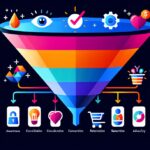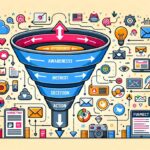Mastering Sales Funnel Creation: Boost Your Conversions

In the realm of online marketing, businesses frequently encounter a common challenge: converting passive leads into active, paying customers. This obstacle often arises due to a lack of structure in the approach to customer conversion. Herein lies the importance of mastering the craft of sales funnel creation.
A sales funnel acts akin to a strategic roadmap that guides potential customers through the buying journey. Each stage in the funnel is meticulously designed to engage and nurture leads, ensuring that they don’t just slip away into the vast digital landscape. Think of it as a crafted experience that transforms curiosity into commitment, and interest into investment.
Without a structured approach, businesses risk losing valuable leads that could be nurtured into loyal customers. This is where an effective sales funnel becomes an indispensable tool. By clearly defining the journey from awareness to decision, and ultimately, to action, businesses can significantly enhance their conversion rates.
For marketers and entrepreneurs aiming to simplify this process, tools like ClickFunnels offer a comprehensive solution. ClickFunnels provides a streamlined platform to design and implement landing pages, automate email marketing, and integrate sales workflows effortlessly, ensuring a smooth journey from lead to client.
Using ClickFunnels, which you can try for free, businesses can easily set up and optimize their sales funnels without the need for extensive technical expertise. The platform’s intuitive interface and powerful features make it easier than ever to guide prospects through the purchase process, keeping them engaged and connected at every touchpoint.
In conclusion, the creation of effective sales funnels is not just about guiding customer interaction but doing so with precision and purpose, leading to improved sales outcomes and accelerated business growth. Whether you’re a startup or an established enterprise, developing a structured sales funnel is a crucial step toward achieving sustained success in the crowded online marketplace.
Explaining Sales Funnels and Their Importance
In today’s competitive marketplace, understanding and implementing effective sales funnel creation is crucial for optimizing sales processes and enhancing customer engagement. But what exactly is a sales funnel, and why is it indispensable for your business?
A sales funnel is a systematic and visual representation of the customer journey from the initial point of contact to the final conversion. Think of it as a filtering process where prospects are gradually guided through various stages: awareness, interest, decision, and action. Each of these stages is designed to engage potential customers with relevant information, nurture their interest, and eventually convert them into loyal clients.
The magic of a sales funnel lies in its ability to provide structure and direction. By understanding customer behavior at each level of the funnel, businesses can tailor their approach, address specific pain points, and build a relationship of trust and value. Unlike a scattergun strategy, a structured sales funnel offers clarity, focusing efforts on those most likely to convert, thus saving time and resources while improving conversion rates.
Moreover, effective sales funnels integrate seamlessly with other marketing components, such as landing pages and email automations. These elements enhance the funnel’s potency by ensuring that leads receive consistent and personalized communication throughout their journey. Landing pages capture initial interest, while automated emails keep the potential customer informed, nurtured, and engaged.
For businesses seeking to craft and optimize their sales funnels without extensive technical expertise, tools like ClickFunnels can be incredibly beneficial. ClickFunnels offers an all-in-one platform that simplifies the process of designing comprehensive sales funnels, including the creation of landing pages and marketing automations. It allows businesses to focus on what truly matters: driving growth and elevating conversions.
Ultimately, mastering the art of sales funnel creation is about more than just selling; it’s about creating a streamlined experience that resonates with your audience, guiding them thoughtfully toward making a purchase. This strategic approach not only boosts conversion rates but also fosters lasting customer relationships, paving the way for sustainable success.
Leveraging Landing Pages for Effective Funnels
In the landscape of sales funnel creation, landing pages serve as vital entry points that can determine the success of your customer acquisition strategy. A landing page is often the first personal interaction that potential customers have with your brand, and its design plays a crucial role in engaging visitors and converting them into leads.
The Role of Landing Pages
In a sales funnel, each stage is integral to guiding potential buyers from the broad pool of prospects to a smaller, more targeted group of qualified leads. The landing page acts as the bridge between initial interest and subsequent action, capturing the visitor’s attention and gently nudging them further down the funnel.
An effective landing page should be laser-focused on a single, clear objective that aligns with the overall goal of the funnel. It’s not about inundating the visitor with information but rather about offering them a clear, concise path to conversion, whether that’s filling out a form, signing up for a newsletter, or making a purchase.
Best Practices for Designing Compelling Landing Pages
To maximize conversion rates, landing pages should be crafted with these best practices in mind:
Clarity of Message: Ensure that your headline and any supporting text clearly communicate the value proposition. Visitors should immediately understand what they stand to gain and why they should take action.
Compelling CTA: Your call to action (CTA) needs to be prominent and persuasive, directing the visitor towards the desired action. Use contrasting colors for buttons and concise, impactful wording.
Visual Appeal: Design plays a significant role in engagement. An aesthetically pleasing layout with clean lines and high-quality images can captivate visitors and make your offer more appealing.
Trust Signals: Incorporate elements like testimonials, reviews, and guarantees to establish credibility and comfort prospective customers about proceeding further.
Mobile Optimization: With an increasing number of users browsing on mobile devices, ensuring your landing pages are mobile-friendly is no longer optional but essential.
The Interconnection of Landing Page Optimization and Funnel Success
Properly optimized landing pages are the cornerstones of effective sales funnel creation. They not only capture leads efficiently but also set the tone for the entire customer journey. A well-designed landing page increases the likelihood of moving prospects to the next stage of the funnel, thereby significantly enhancing conversion rates.
For those looking to streamline the design and optimization of these critical components, tools like ClickFunnels are invaluable. ClickFunnels offers a platform that simplifies the integration of landing pages within your sales funnel, providing an intuitive interface that allows you to build, test, and refine pages with ease. By leveraging ClickFunnels here, businesses can enhance the user experience, optimizing the sales workflow to drive growth effectively.
In summary, leveraging well-crafted landing pages is a strategic move in sales funnel creation. They are the touchpoint where potential customers transition from mere interest to active engagement, setting the stage for successful conversions. By focusing on the user experience and utilizing powerful tools to optimize pages, businesses lay the foundation for a robust and effective sales funnel.
Integrating Sales Workflows and Email Automations
A well-structured sales funnel is much like a finely tuned machine, where each part works in harmony to drive optimal results. Among the crucial components of this mechanism are sales workflows and email automations. These elements play an essential role in not only streamlining customer interactions but also maintaining continuous engagement and nurturing leads through personalized communication.
The Role of Sales Workflows
Sales workflows encompass the series of automated processes that systematically guide leads through each stage of the customer journey. These workflows make certain that every interaction a prospect has with your business is purposeful and directed. By defining specific actions triggered by user behavior or predefined criteria, sales workflows ensure that every lead is nurtured appropriately.
For example, when a potential customer signs up for a newsletter, a workflow might trigger a sequence of emails that introduce the prospect to your brand’s value propositions, eventually leading them to special offers or product demos. Sales workflows keep leads moving smoothly through the funnel, ensuring no touchpoint is missed and converting interest into sustained engagement.
The Power of Email Automations
Email automations work hand-in-hand with sales workflows to create a seamlessly orchestrated communication strategy. These automations ensure that potential customers receive the right message at the right time, without manual intervention, thus saving valuable resources while enhancing engagement.
Email automations can vary from welcome series and educational drip campaigns to re-engagement strategies and post-purchase follow-ups. With the personalization capability, businesses can address specific needs or preferences, making the interaction more relevant and impactful.
Streamlining Customer Interactions
Integrating sales workflows and email automations into your sales funnel simplifies the process of maintaining consistent communication with leads. This integration helps in delivering targeted messages based on customer actions or journey stage, enriching the user experience and reinforcing brand value.
Leveraging ClickFunnels for Effective Integration
For those seeking to integrate these critical components without the technical hassle, ClickFunnels offers a solution. The platform facilitates the seamless integration of sales workflows and email automations into your sales funnel, making it easier to manage and optimize interactions.
With ClickFunnels, businesses can design comprehensive and automated sales funnels that require minimal manual oversight. This ease of use combined with its robust features ensures that businesses can focus more on crafting strategic messages and less on the mechanics of delivery. Explore how ClickFunnels can aid in your funnel strategy here. By doing so, you ensure that your communications are condensed into a streamlined process, enabling you to effectively move prospects towards becoming committed customers.
In essence, integrating sales workflows and email automations is pivotal for any business looking to maintain engagement and nurture leads efficiently. By automating these processes, businesses can provide a smoother, more personalized journey, ultimately leading to higher conversion rates and stronger customer relationships. This integration is not just a convenience but a necessity in optimizing the sales funnel for maximum effectiveness and growth.
Conclusion: Summing Up Sales Funnel Optimization
In today’s fiercely competitive digital marketplace, the ability to convert prospects into loyal customers is paramount. Mastering the art of sales funnel creation is not just an option but a necessity for businesses aiming for sustainable growth. Through our exploration of the components that make a sales funnel effective, it’s evident that each element—landing pages, sales workflows, and email automations—plays a critical role in achieving conversion success.
The Power of Landing Pages
Landing pages are the initial touchpoints that captivate visitors and usher them into the funnel. Their design and clarity are crucial in maintaining a prospect’s interest and guiding them towards making informed decisions. By employing best practices such as mobile optimization, compelling CTAs, and a clear message, landing pages can significantly influence conversion rates.
The Efficiency of Sales Workflows and Email Automations
Once prospects are engaged, the integration of sales workflows and email automations ensures that the customer journey is seamless and personalized. These automated systems work behind the scenes, ensuring that every interaction feels thoughtful and tailored, fostering stronger connections and a higher likelihood of conversion. They automate the repetitive yet critical tasks, allowing businesses to focus on crafting messages that speak to the hearts and minds of their audience.
The Structured Approach to Sales Funnel Success
The culmination of these elements—well-optimized landing pages, efficient sales workflows, and strategic email automation—creates a robust sales funnel. This structured approach not only enhances immediate sales outcomes but also builds a loyal customer base that supports long-term business growth.
For those seeking to streamline the assembly and optimization of their sales funnels, tools like ClickFunnels are invaluable. ClickFunnels provides a comprehensive platform for designing, implementing, and refining sales funnels with ease. With features that cater to every aspect of the funnel process, from landing page design to email automation, ClickFunnels eliminates technical barriers, allowing businesses to focus on strategic growth and customer engagement.
In summary, effective sales funnel optimization hinges on the strategic use of landing pages, sales workflows, and email automations—components that work in harmony to guide your potential customers through a transformative buying journey. By adopting a structured approach and leveraging tools like ClickFunnels, businesses can not only improve their conversion rates but also accelerate their growth in an increasingly competitive landscape.





